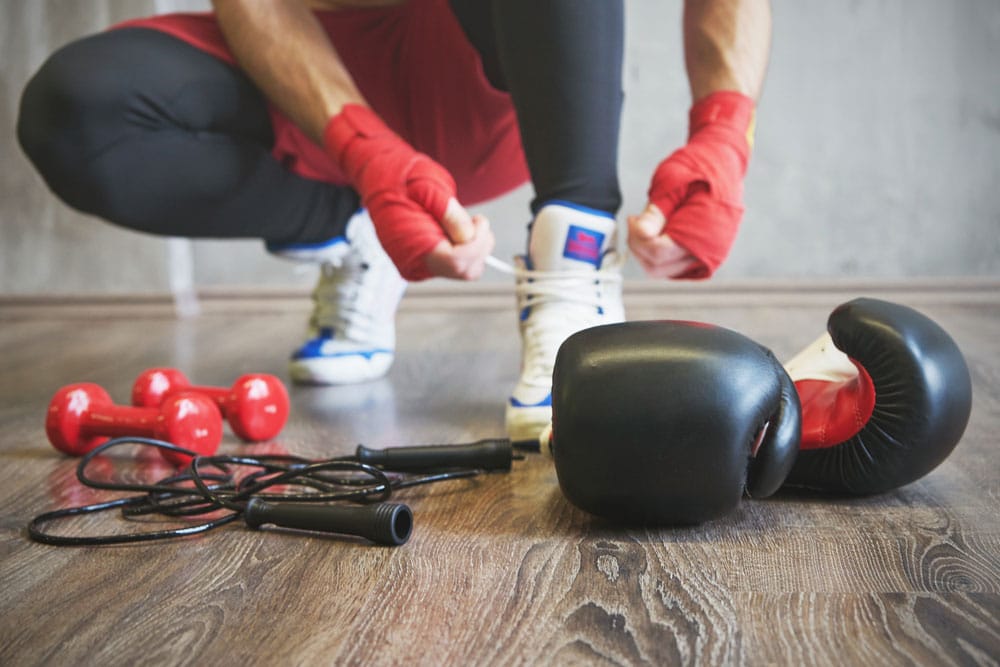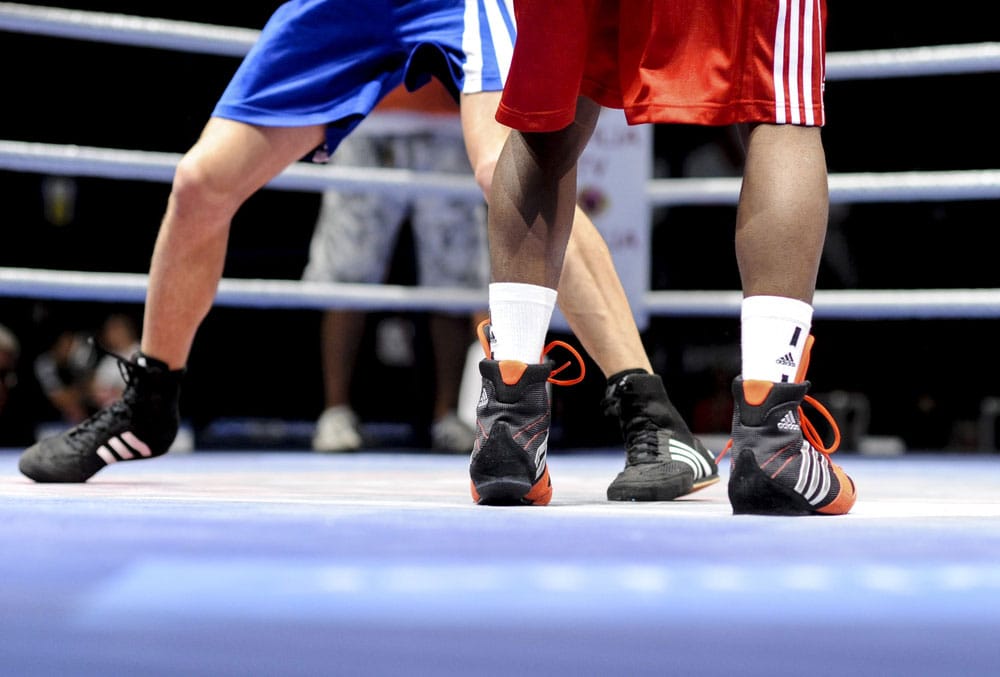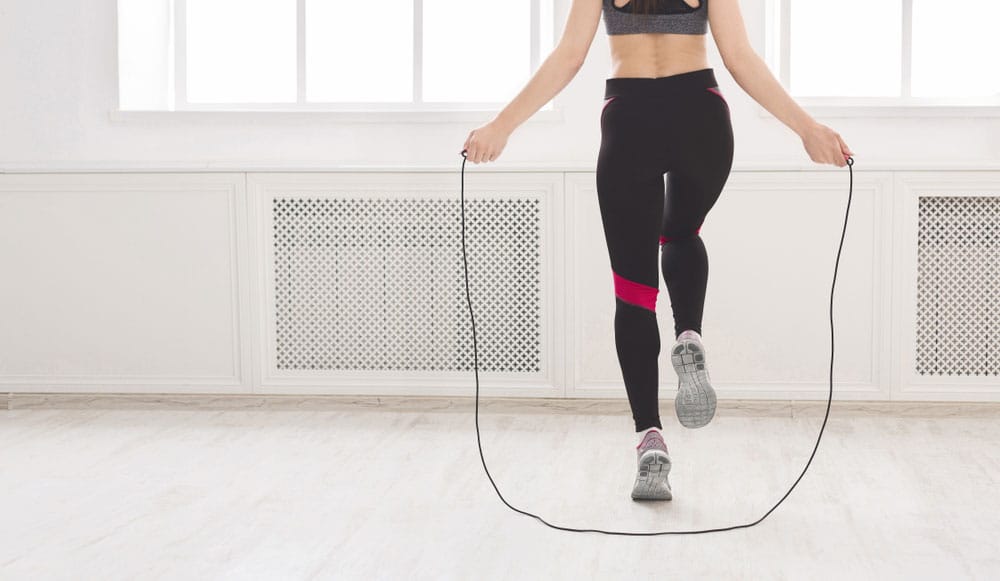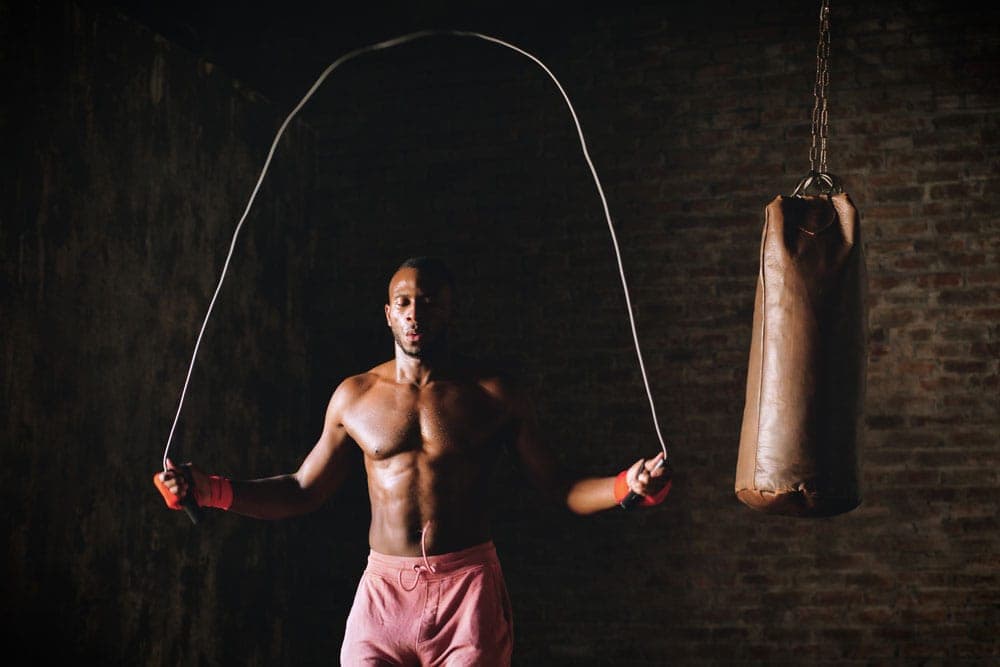How to Jump Rope Like a Boxer
This is a guide to how to jump rope like a boxer. Learn how jumping rope can help you train for boxing matches.
If you plan to tune into the Mike Tyson vs. Jake Paul fight this summer, you may be investigating how to train like a pro boxer.
Boxing training is unique. It combines speed, power, and agility-based moves. Athletes spend hours in the gym looking to get up to scratch for their matches and to cut weight to squeeze into weight classes.
Jumping rope is one of the go-to moves that boxers use to get fit for fighting. But what’s so beneficial about jumping rope for boxing anyway?
Here, we’ll review the benefits of jump rope workouts learn why boxers work out with jump ropes and examine what the major similarities and differences are between jump rope types.
Let’s learn how to jump rope like a boxer.
Why Do Boxers Jump Rope?

If you go through a list of the greats: Manny Pacquiao, Mike Tyson, Muhammad Ali, and Sugar Ray Leonard, it would be near impossible to find one who didn’t jump rope as part of their boxing training program.
A workout routine that incorporates skipping or some sort of jump rope has direct benefits not only on your heart health but also your ability to “float like a butterfly,” in the wise words of Ali.
Stinging like a bee to strike your opponents is far from the only essential skill you must master to ascend among the ranks of great fighters.
How you hold yourself in the ring and your ability to move effortlessly is just as crucial.
It may not relate directly to their sport. But jumping rope is one of the best conditioning techniques for boxers. There are several areas in which jump rope can enhance at athlete’s performance in the ring. These include:
Stamina
A professional boxing match lasts for around 12 three-minute rounds. Each of these rounds offers only a minute or so of rest in between. This fight structure is quite taxing on an athlete’s cardiovascular system.
For endurance training, jump rope is a great way for boxers to improve their stamina.
Cross-Training
Although you don’t use a rope in boxing, research suggests that jumping rope is an effective cross-training tool for many athletic disciplines.
In a Jump Rope Training study, researchers found that training with jump ropes benefitted both motor coordination and balance in a group of young soccer players who were studied over eight weeks.
This suggests that jumping rope may have non-sport-specific benefits on skills that can translate into a variety of athletic activities.
Like soccer, boxing requires a high level of coordination and balance. Athletes need to stay on their toes both literally and figuratively. Training with a jump rope allows them to work their balance and coordination in a medium that translates not only to their sport but builds functional mobility.
Arm and Wrist Strength
One of the best perks about jumping rope for a boxer is the benefits for the arms and wrists. To jab, cross, or hook an opponent, you need hands that can ball up into firm fists and wrists that can withstand the impact of a solid punch.
Turning a rope round and round is a wrist-circling movement that is quite simple for most to do. Although it may feel passive for the most part, you’re building a lot of strength and mobility in the wrists and arms as you turn your rope.
Boxing Footwork

A boxer always needs to stay light on their feet. After all, some of these athletes are dodging punches that sail through the air at over 30 miles per hour!
In a real match, hand-to-hand combat is often followed by a waiting period where boxers need to stay “on their toes” (okay, specifically, on the balls of their feet).
Here, they “pulse” or jump lightly to maintain the adrenaline levels needed for a tough fight, stay ready for action as the fight progresses and keep their muscles warm.
Those are some speedy attacks that you need to set yourself up for. One of the key methods boxers use to train their footwork is jumping rope.
Boxers also need to perfect what is (aptly!) named the “boxer’s skip.” This foot-to-foot heel-toe motion is the perfect way for boxers to maintain their sense of mental alertness and readiness to strike in a fight situation.
Here’s a quick overview of the boxer’s skip.
Benefits of Jumping Rope for Boxers
Cardio
Jumping rope is a great way to improve your cardiovascular health. The jumping motion that you perform is a great way to increase your heart rate.
The health benefits of aerobic exercise include a reduction of the risk of heart disease. Jumping rope and other cardio can also help with the management of conditions like diabetes.
Not only this, cardio can help you lose weight. Whether you’re looking to move down a weight class or simply fit into a snug pair of pants, overall fat loss may be aligned with your fitness goals. Scaling up your cardio is one way to work towards this, and many people find jumping rope more fun and mentally stimulating than the treadmill.
To learn more about cardiovascular exercise, here are some resources for you:
Grows the Calves
Jump rope is a good way to isolate your calves. Since you bounce on the balls of your feet, the calves are in an optimal position to get a good workout when you jump rope.
Bouncing in the air puts strain on your calf muscles and is a great gastrocnemius and soleus exercise to get the two major calf muscles working. Since many people don’t train calves efficiently, this is a great way to put pressure on your calves and force them to grow.
Which Jump Rope Should I Use?

One of the biggest benefits of jumping rope is that it’s simple and inexpensive. Most ropes will run you less than $30, making it one of the most affordable workouts on the market.
Boxers do tend towards some specific ropes, however. Most commonly speed ropes.
Speed Ropes
Speed ropes are the lightest and thinnest option for jump rope training. To work on coordination and agility these are the most suitable type of jump rope for most athletes. These ropes are incredibly lightweight and easy to spin quickly.
If you want to perform complex moves that require brainpower and ultimate speed, like double unders (where you bring the rope under your feet twice quickly between jumps), speed ropes make a good option.
Weighted Ropes
Weighted ropes are heavier with larger handles. These are a notable option for strengthening the muscles. Weighted ropes can help an athlete to build more core strength and fundamental muscle.
How Can I Jump Rope Like a Boxer?
Boxers include jumping rope in their training routines in a variety of ways. Sometimes it is used as a simple steady-state cardio warm-up for 10-20 minutes.
You can also use jump rope as a type of high-intensity interval training. Boxers may jump at top speed for 1-2 minutes then take a 1-minute break, repeating a 1-on-1-off structure (or however long they can manage to keep their maximum intensity going) for as long as they need.
This type of training more closely resembles the conditions you would be up against in an actual match, with heart rate spikes from intense combat followed by waiting periods.
In an analysis, researchers found that there are benefits to both short-duration (under 30 seconds) and long-duration (3 minutes) bouts of skipping as a form of vigorous exercise. The upper end of the studied range, around 3 minutes, was found to be the most effective for strengthening the cardiorespiratory system.
You can learn more in Short vs. Long Bouts of Rope Skipping.
Is Jump Rope Better than Running?
We’ve all seen it: the famous scene in Rocky where the titular character, Rocky Balboa, runs up the steps at the Philadelphia Museum of Art. It’s had a lasting effect on generations of young boxing fans and shows clear proof that running is an essential part of boxing training. But is running better for boxers (or for you) than jump rope?
If you do it correctly, jumping rope is generally lower impact than running. This means it puts less direct strain on the joints.
That said, the boxer’s skip can still cause injury, particularly to your ankles. If you don’t make an effort to strengthen the ankle joints, the back-and-forth skipping can easily cause an ankle to slide out from under you and sprain.
Conclusion
Maybe you don’t want to exercise for a Spiderman physique, master a Daniel Craig workout, get a male gymnast body or perform a Greek God workout. Perhaps a Herschel Walker workout, MMA-style, is closer to your style. But more specifically, you want to hone in on the boxing component.
Jumping rope like a boxer is one of the most fun and cost-effective ways to improve your cardiovascular health, have fun, and cross-train for other sports.
The simple exercise has been practiced over the years by many of the greatest athletes in the sport of boxing.
To jump rope like a boxer, you’ll need to find a rope that suits you. Either a lightweight speed rope is best if you want to focus on your agility and stamina. Or a weighted rope could be for you if you’re looking to improve your muscular strength.
The way you break down your training is up to you. Try out a 10- to 20-minute jump rope session if you’re using it to warm up for another type of workout.
You can also break your rope jumping into interval training: Go hard for a 30-second to 3-minute sprint, then take one minute off as a break. Rinse and repeat.
Depending on what result you’re looking for, you can choose to switch things up during your jump rope workout. Remember to always stretch after you jump rope.
These tips can help ensure your next workout is a TKO.
References
Chow GC-C, Sun F, Kam KW-K, Kong Y-H, Zhang B. Short vs. Long Bouts of All-Out Rope Skipping: Effects on Metabolic and Perceptual Responses. Applied Sciences. 2023; 13(12):7072. https://doi.org/10.3390/app13127072
Halabchi, F., & Hassabi, M. (2020). Acute ankle sprain in athletes: Clinical aspects and algorithmic approach. World journal of orthopedics, 11(12), 534–558. https://doi.org/10.5312/wjo.v11.i12.534
Mersy D. J. (1991). Health benefits of aerobic exercise. Postgraduate medicine, 90(1), 103–112. https://doi.org/10.1080/00325481.1991.11700983
Trecroci, A., Cavaggioni, L., Caccia, R., & Alberti, G. (2015). Jump Rope Training: Balance and Motor Coordination in Preadolescent Soccer Players. Journal of sports science & medicine, 14(4), 792–798.
Related articles


Get fit with Flex
Build muscle & lose weight fast for free.
Available on iPhone + Apple Watch





